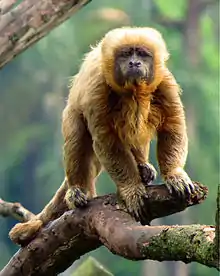Blond capuchin
The blond capuchin (Sapajus flavius) is a species of the capuchin monkeys group, the genus Sapajus. This endangered species was rediscovered in 2006. It is endemic to northeastern Brazil.
| Blond capuchin | |
|---|---|
 | |
| Scientific classification | |
| Kingdom: | Animalia |
| Phylum: | Chordata |
| Class: | Mammalia |
| Order: | Primates |
| Suborder: | Haplorhini |
| Infraorder: | Simiiformes |
| Family: | Cebidae |
| Genus: | Sapajus |
| Species: | S. flavius |
| Binomial name | |
| Sapajus flavius Schreber, 1774 | |
 | |
| Blond capuchin range | |
| Synonyms | |
|
Cebus queirozi Mendes Pontes and Malta, 2006 | |
Classification
The blond capuchin was first described as "caitaia" by Georg Marcgrave in 1648.[2] In 1774 Johann Christian Daniel von Schreber posited Simia flavia as an independent species, but it had long lacked any specimen.[3] It was not until in 2006 when researchers made its neotype designation.[4] In their neotype designation article, de Oliveira and Langguth confirmed the consistency of Marcgrave’s, Schreber’s, and their capuchins, attributed the authority to Schreber, and established a new combination of its scientific name, C. flavius Schreber, 1774.
In the same year, 2006, Mendes Pontes and Malta reported C. queirozi as a new species.[5] However, de Oliveira and his collaborators pointed out the existence of the previous studies, that is, those of Marcgrave and Schreber, as well as the inadequacy of Mendes Pontes and Malta's designation of the type specimen, and therefore considered C. queirozi to be a junior synonym.[1][4] Rylands and Mittermeier followed de Oliveira and Langguth’s view.[6]
In 2011, Jessica Lynch Alfaro et al. proposed that the robust capuchins such (formerly the C. apella group) be placed in a separate genus, Sapajus, from the gracile capuchins (formerly the C. capucinus group) which retain the genus Cebus.[7][8]
Description
Pelage uniformly golden; whitish cap on the head; face pinkish; palms of the hands and feet black. Head and body about 35–40 cm; tail nearly equivalent. Weight about 2–3 kg.[4][5]
Distribution
This species inhabits the northeastern Atlantic Forest extended in the states of Paraíba, Pernambuco, and Alagoas in the northeastern part of Brazil.[4][5] The blond capuchin was rediscovered in two Atlantic Forest fragments in Paraíba, the Camaratuba Experimental Station and the Engenho Gargaú Private Natural Heritage Reserve. Sample animals were captured and examined. In the Gargaú reserve they seemed healthy and were probably a viable population for the next 100 years. The Camaratuba population had a 50% risk of extinction.[9] They have also been seen in the Pau-Brasil Ecological Station in Paraíba, just south of the Camaratuba station.[10]
References
- Valença Montenegro, M., Bezerra, B., Fialho, M., Jerusalinsky, L., Lynch Alfaro, J. & Martins, A.B. (2020). "Sapajus flavius". IUCN Red List of Threatened Species. 2020: e.T136253A70612866.CS1 maint: multiple names: authors list (link)
- Marcgrave, G. (1648), "Liber sextus: De quadrupedibus, et sepentibus", Historiae rerum naturalium Brasiliae, Lugdunum Batavorum: Franciscus Hackius, pp. 226–227, retrieved 4 May 2009, cited by de Oliveira & Langguth 2006.
- Schreber, J. C. D. von (1774), Die Säugethiere in Abbildungen nach der Natur, mit Beschreibungen, Leipzig: Siegfried Leberecht Crusius, cited by de Oliveira & Langguth 2006.
- de Oliveira, M. M.; Langguth, A. (2006), "Rediscovery of Marcgrave's capuchin monkey and designation of a neotype for Simia flavia Schreber, 1774 (Primates, Cebidae)." (PDF), Boletim do Museu Nacional: Nova Série: Zoologia, 523, pp. 1–16, archived from the original (PDF) on 5 February 2009, retrieved 4 May 2009
- Mendes Pontes, A. R.; Malta, A.; Asfora, P. H. (2006), "A new species of capuchin monkey, genus Cebus Erxleben (Cebidae, Primates): Found at the very brink of extinction in the Pernambuco Endemism Centre." (PDF), Zootaxa, 1200, pp. 1–12, retrieved 4 May 2009
- Rylands, A. B.; Mittermeier, R. A. (2009), "The diversity of the New World primates (Platyrrhini): An annotated taxonomy", in Garber, P. A.; Estrada, A.; Bicca-Marques, J. C.; Heymann, E. W.; Strier, K. B. (eds.), South American primates: Comparative perspectives in the study of behavior, ecology, and conservation, New York: Springer Science+Business Media, pp. 23–54, ISBN 978-0-387-78704-6
- Lynch Alfaro, J.W.; et al. (2011). "Explosive Pleistocene range expansion leads to widespread Amazonian sympatry between robust and gracile capuchin monkeys" (PDF). Journal of Biogeography. 39 (2): 272–288. doi:10.1111/j.1365-2699.2011.02609.x. Archived from the original (PDF) on 26 February 2015.
- Lynch Alfaro, J.W.; Silva, j. & Rylands, A.B. (2012). "How Different Are Robust and Gracile Capuchin Monkeys? An Argument for the Use of Sapajus and Cebus". American Journal of Primatology. 74 (4): 1–14. doi:10.1002/ajp.22007. PMID 22328205. S2CID 18840598.
- Valença Montenegro, Mônica Mafra (5 December 2011), Ecologia de Cebus flavius (Schreber, 1774) em remanescentes de Mata Atlântica no estado da Paraíba (Thesis), Universidade de São Paulo, doi:10.11606/T.91.2011.tde-20122011-143229
- Michelle Scarione, "Mamanguape é região importante para preservação do pau-brasil", Paraíba Urgente (in Portuguese), archived from the original on 23 September 2016, retrieved 28 May 2015
| Wikispecies has information related to Cebus queirozi. |
| Wikimedia Commons has media related to Cebus flavius. |
